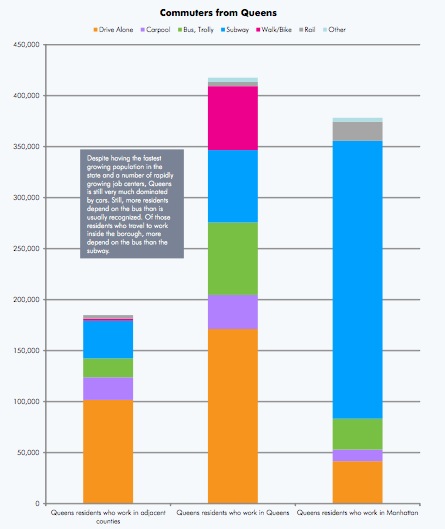
Over the last decades, the economic geography of New York City has begun to shift. While Midtown and Lower Manhattan remain job centers without peer, more and more of the city's jobs are located outside of the central business districts. As employment shifts into the other boroughs, however, the transit system hasn't shifted with it. That means longer waits and worse service for many New Yorkers, especially for low- and middle-income workers, according to a new report from the Center for an Urban Future.
To connect people to jobs and expand economic opportunity in the city, the authors write, bus service must improve dramatically and transit must become a "kitchen table issue" for a broader range of New Yorkers.
Increasingly, New Yorkers' commutes don't take them into Manhattan. In the Bronx, for example, between 1990 and 2008 the number of commuters traveling to Manhattan grew by 12 percent. The number of commuters going to work inside the Bronx, in contrast, grew by 25 percent and the number traveling to neighboring Queens or Westchester increased by 38 percent. In fact, the Bronx was the only borough to add jobs during the great recession. The pattern, which repeats itself in Brooklyn, Queens, and Staten Island, is clear: commuting no longer means traveling into Manhattan.
With the subway system designed to funnel people in and out of Manhattan, New Yorkers rely on bus service to take them to these new jobs. Bus ridership is up 60 percent since 1990. But increased ridership and increased traffic congestion mean that bus trips are slower than ever. Last year's service cuts, which hardest on bus riders, only exacerbated the situation. It's no wonder, therefore, that New Yorkers' commute lengths just keep increasing. The problem is particularly acute among low-income New Yorkers, whose homes and jobs are more likely to be in transit-poor neighborhoods and who can't afford to drive.
The shoddy state of bus service to New York's new jobs is a major obstacle to economic opportunity.
The Center for an Urban Future report quotes Sharon Valentin, the tenant association leader for Staten Island's Castleton Houses: "We have a new Target on the other side of the island and the bus lets you off a half a mile away. I know a lot of people here who would like to work at that Target, but getting there every day is too hard."
Employers, too, see inadequate transit service as an obstacle to growth. "Improved mass transit would allow our expanding business to draw from a larger labor pool, improve our ability to attract and retain new workers and make us a more competitive manufacturer," said Steve Chen, the vice president the rapidly expanding Crystal Windows and Doors in College Point, Queens.

To help connect New Yorkers with the new jobs, the Center for an Urban Future suggests a serious investment in bus rapid transit. While it praises the city DOT and the MTA for the successful projects on Fordham Road and First and Second Avenues, it concludes that "to have any real impact on commute times, particularly for the working poor living outside of Manhattan, an even more ambitious effort is needed."
That means building out the city's 19 identified candidates for a second phase of Select Bus Service but also adding to that plan in important ways. The report recommends adding elevated platforms to speed boarding and alighting and to provide bus service with some additional cultural cachet. More importantly, perhaps, it calls for adapting that plan to the realities of New York's new job centers. Not one proposed SBS route travels from Queens to the Bronx or Brooklyn.
It's also worth pointing out the importance of non-Manhattan commutes for sustainability goals as well. Only a tiny share of car commutes from any borough are to Manhattan; most are entirely within another borough or to an adjacent county. To reduce driving, those routes need good transit.
To make a robust, citywide BRT system a reality, however, the politics of transit need to change. As the report's authors write, "the MTA and DOT don't operate in a vacuum." The MTA can't take on any major new commitments until its budget is balanced, which will require new revenue (CUF recommends considering congestion pricing or bridge tolls). And BRT won't be rolled out citywide if local leaders, like those who killed the Queens Merrick Boulevard SBS route, continue to fight against it.
The key, the report argues, is to make transportation more of a "kitchen-table issue." Right now, they note, only seven percent of New Yorkers making below 200 percent of the federal poverty line identify transit as the biggest challenge facing New York, compared to 11 percent of higher-income residents.
An important part of putting transportation equity on the agenda will be convincing the most important advocates for workers to put it on theirs. "Transportation is a big problem for our lowest wage workers," said Leah Gonzalez, the communications director for SEIU/1199, the powerful health care union which represents home health care workers who must crisscross the city for work. Gonzalez told CUF, however, that transportation wasn't generally an issue her union advocated for.





